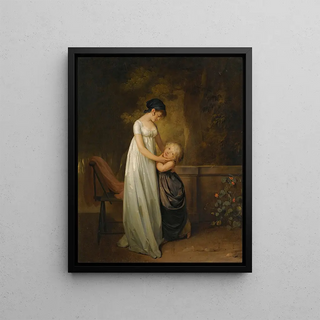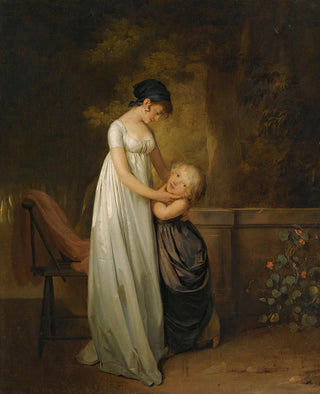Art print | Les Caresses maternelles - Louis Léopold Boilly


View from behind

Frame (optional)
In the vast panorama of art history, certain works stand out for their ability to capture moments of rare emotional intensity. "Les Caresses maternelles" by Louis Léopold Boilly is one such piece. Painted in the early 19th century, it evokes tenderness and the sweetness of family bonds through the depiction of a mother and her child. The scene portrays a moment of complicity and affection, where the mother's gaze, filled with love, rests on her child, while the latter appears immersed in a world of daydreams. This work, both intimate and universal, invites us to reflect on the beauty of human relationships and the fundamental role of motherhood.
Style and uniqueness of the work
Boilly's style is characterized by meticulous attention to detail and exceptional mastery of light. In "Les Caresses maternelles," the artist uses a palette of soft, warm colors that enhance the peaceful atmosphere of the scene. The textures of clothing and hair are rendered with precision, demonstrating his technical skill. The piece also stands out for its realistic approach, typical of Neoclassicism, while incorporating elements of Romanticism. Boilly manages to create an atmosphere of closeness and intimacy, making the viewer a privileged witness to this fleeting moment. The composition is carefully balanced, with each element placed thoughtfully, contributing to the overall harmony of the work. This ability to marry realism and emotion makes "Les Caresses maternelles" a masterpiece that continues to touch hearts.
The artist and his influence
Louis Léopold Boilly, born in 1761, is often regarded as a pioneer of portraiture and genre scenes. Active in Paris, he captured the spirit of his time, oscillating between Neoclassical influences and the early stages of Romanticism. His work is marked by sharp observation of daily life and the customs of his era. Boilly established himself as an essential artist, influencing many contemporaries and future artists. His approach to light and color has

Matte finish

View from behind

Frame (optional)
In the vast panorama of art history, certain works stand out for their ability to capture moments of rare emotional intensity. "Les Caresses maternelles" by Louis Léopold Boilly is one such piece. Painted in the early 19th century, it evokes tenderness and the sweetness of family bonds through the depiction of a mother and her child. The scene portrays a moment of complicity and affection, where the mother's gaze, filled with love, rests on her child, while the latter appears immersed in a world of daydreams. This work, both intimate and universal, invites us to reflect on the beauty of human relationships and the fundamental role of motherhood.
Style and uniqueness of the work
Boilly's style is characterized by meticulous attention to detail and exceptional mastery of light. In "Les Caresses maternelles," the artist uses a palette of soft, warm colors that enhance the peaceful atmosphere of the scene. The textures of clothing and hair are rendered with precision, demonstrating his technical skill. The piece also stands out for its realistic approach, typical of Neoclassicism, while incorporating elements of Romanticism. Boilly manages to create an atmosphere of closeness and intimacy, making the viewer a privileged witness to this fleeting moment. The composition is carefully balanced, with each element placed thoughtfully, contributing to the overall harmony of the work. This ability to marry realism and emotion makes "Les Caresses maternelles" a masterpiece that continues to touch hearts.
The artist and his influence
Louis Léopold Boilly, born in 1761, is often regarded as a pioneer of portraiture and genre scenes. Active in Paris, he captured the spirit of his time, oscillating between Neoclassical influences and the early stages of Romanticism. His work is marked by sharp observation of daily life and the customs of his era. Boilly established himself as an essential artist, influencing many contemporaries and future artists. His approach to light and color has






